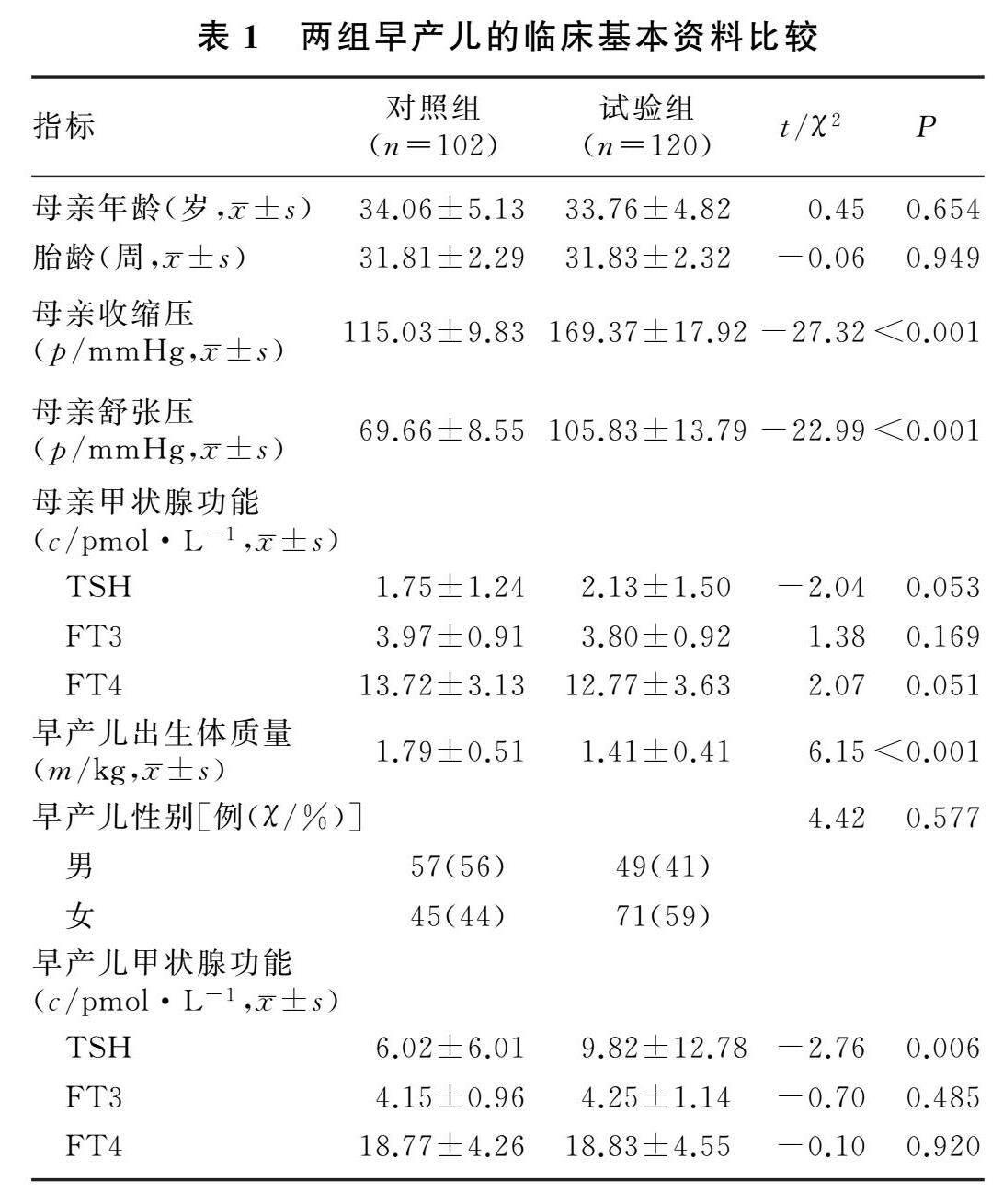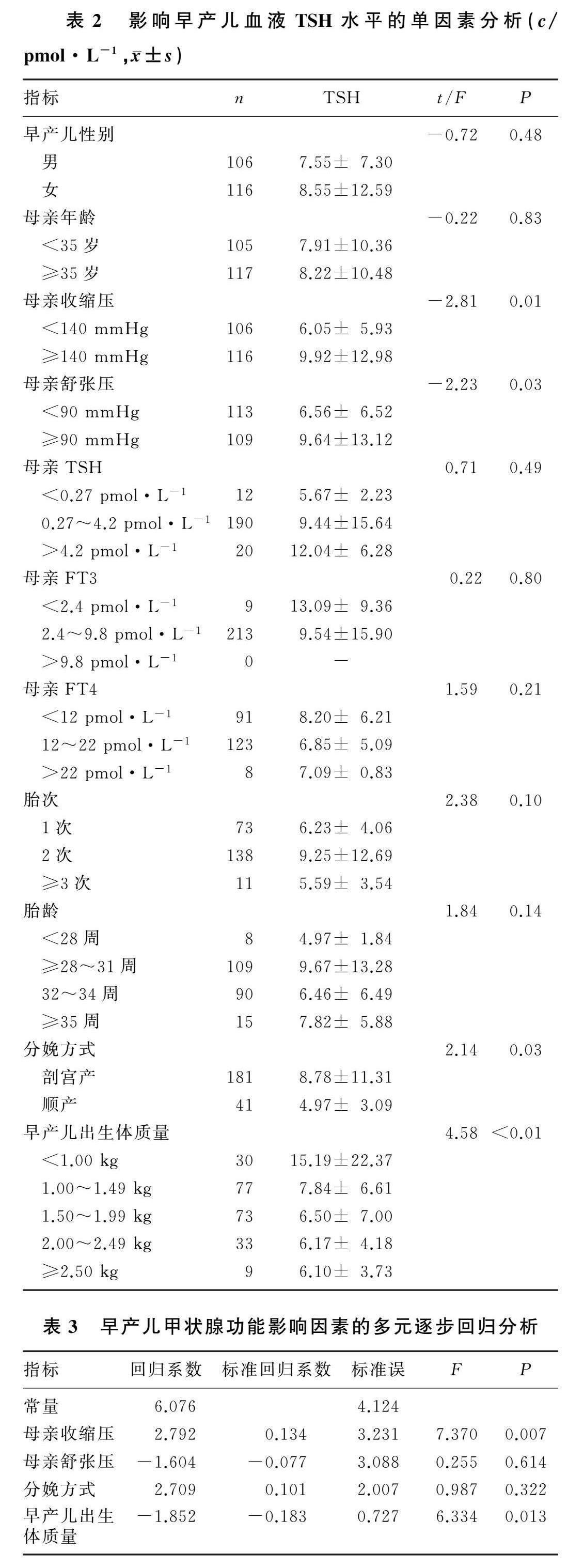子痫前期母亲分娩早产儿甲状腺功能的特点及其影响因素分析
刘子艳 姜红 张璐璐 张沂洁 李婷 刘燕


[摘要] 目的 探討子痫前期母亲分娩早产儿甲状腺功能的特点及其影响因素。
方法选取2019年1—12月于我院新生儿重症监护病房住院的222例早产儿,根据其母亲有无子痫前期,分为试验组120例和对照组102例。收集两组早产儿及其母亲的临床基本资料,以及早产儿生后10~14 d的外周静脉血甲状腺功能检测结果。采用Student-t检验、单因素方差分析及多元逐步回归分析评价早产儿甲状腺功能的影响因素。
结果两组早产儿母亲的甲状腺功能没有显著差异(P>0.05)。试验组早产儿血清促甲状腺激素(TSH)水平显著高于对照组(t=-2.76,P<0.01)。多元逐步回归分析显示,母亲的收缩压及早产儿的出生体质量是早产儿甲状腺功能的主要影响因素(F=7.370、6.334,P<0.05)。
结论子痫前期母亲分娩早产儿血清TSH水平显著高于血压正常母亲分娩早产儿,早产儿血清TSH水平与母亲甲状腺功能无明显相关性。
[关键词] 子痫前期;分娩;甲状腺功能试验;影响因素分析;婴儿,早产
[中图分类号] R722.6;R335.2
[文献标志码] A
Characteristics of thyroid function and its influencing factors in preterm infants born to mothers with preeclampsia
LIU Ziyan, JIANG Hong, ZHANG Lulu, ZHANG Yijie, LI Ting, LIU Yan
(Childrens Medical Center, The Affiliated Hospital of Qingdao University, Qingdao 266003, China)
;[ABSTRACT] Objective To investigate the characteristics of thyroid function and its influencing factors in preterm infants born to mothers with preeclampsia.
Methods A total of 222 preterm infants, who were admitted to the neonatal intensive care unit of our hospital from January to December 2019, were enrolled, and according to the presence or absence of preeclampsia in the mother, they were divided into experimental group with 120 infants and control group with 102 infants. Basic clinical data were collected from the preterm infants and their mothers, as well as the results of thyroid function test using peripheral venous blood of preterm infants at 10-14 d after birth. The Students t-test, a one-way analysis of variance, and the multiple stepwise regression analysis were used to investigate the influencing factors for thyroid function in preterm infants.
Results There was no significant difference in maternal thyroid function between the two groups (P>0.05). The experimental group had a significantly higher se-
rum level of thyroid stimulating hormone (TSH) than the control group (t=-2.76,P<0.01). The multiple stepwise regression analysis showed that systolic pressure of the mother and birth weight of the preterm infant were the main influencing factors for thyroid function in preterm infants (F=7.370,6.334,P<0.05).
Conclusion Preterm infants born to mothers with preeclampsia have a significantly higher serum level of TSH than those born to mothers with normal blood pressure, and there is no significant association between serum TSH level of preterm infants and maternal thyroid function.
[KEY WORDS] Pre-eclampsia; Parturition; Thyroid function tests; Root cause analysis; Infant, premature
目前,全球范围内妊娠期高血压疾病的发病率高达2%~8%,其中最常见的是子痫前期,子痫前期被认为是导致新生儿死亡的重要原因之一[1-2]。子痫前期可导致胎盘功能下降,影响胎儿的氧气和营养供给,如处理不及时将对胎儿健康产生严重影响[3]。最近国内外研究发现,子痫前期母亲分娩早产儿甲状腺功能异常的发生率明显升高[4-6]。然而,导致这些早产儿甲状腺功能异常的原因尚不明确。本研究通过分析子痫前期母亲分娩早产儿的甲状腺功能特点,探讨其可能的影响因素,为子痫前期母亲分娩早产儿异常甲状腺功能的早期检测及防治提供指导。
1 资料与方法
1.1 一般资料
选取2019年1—12月于我院新生儿重症监护病房住院的早产儿共222例。纳入标准:①单胎,胎龄<37周者;②母亲无甲状腺疾病史,且无使用影响甲状腺功能药物史者。排除标准:①甲状腺发育异常者;②甲状腺功能检查前使用过影响甲状腺功能药物者,包括胺碘酮、干扰素、糖皮质激素、抗癫痫药物等;③有先天性遗传代谢性疾病者。所有早产儿根据母亲有无子痫前期,分为试验组120例和对照组102例。子痫前期的诊断参照第九版《妇产科学》中的标准[7]。
1.2 观察指标
收集所有早产儿性别、胎龄、胎次、出生体质量等临床基本资料;收集早产儿生后10~14 d外周静脉血甲状腺功能检查结果,包括血清游离甲状腺素(FT4)、游离三碘甲状腺原氨酸(FT3)和促甲状腺激素(TSH)水平。对于血清TSH>10 pmol/L的早产儿,同时收集甲状腺发育情况的超声检查结果。收集母亲妊娠期甲状腺功能、分娩年龄、分娩方式及分娩前收缩压、舒张压等临床基本资料。
1.3 统计学分析
采用SPSS 22.0软件进行统计学分析。计量资料以 ±s表示,两组间比较采用Student-t检验,多组间比较采用单因素方差分析;计数资料以例(率)表示,两组间比较采用卡方检验;危险因素分析采用多元逐步回归分析。以P<0.05为差异有显著性。
2 结 果
2.1 两组早产儿临床基本资料比较
两组早产儿的胎龄、性别及母亲的甲状腺功能、分娩年龄比较差异无显著性(P>0.05)。试验组早产儿母亲分娩前收缩压和舒张压、早产儿出生体质量、早产儿血清TSH水平与对照组比较,差异有显著性(t=-27.32~6.15,P<0.05)。见表1。所有早产儿中血清TSH>10 pmol/L者36例,超声检查均未见甲状腺发育异常。
2.2 影响早产儿血液TSH水平的单因素分析
单因素分析结果显示,母亲分娩前的收缩压与舒张压、早产儿出生体质量及分娩方式对早产儿血液TSH水平均有显著影响(t=-2.81~2.14,F=4.58,P<0.05),而母亲的年龄、甲状腺功能、胎次、胎龄及早产儿性别对早产儿甲状腺功能无显著影响(P>0.05)。见表2。
2.3 早产儿甲状腺功能影响因素的多元逐步回归分析
以早产儿甲状腺功能水平为因变量,以单因素分析中有差异的因素为自变量,进行多元逐步回归分析,赋值情况:母亲收缩压(<140 mmHg=1,≥140 mmHg=2),母亲舒张压(<90 mmHg=1,≥90 mmHg=2),分娩方式(顺产=1,剖宫产=2),早产儿出生体质量(<1.0 kg=1,1.0~1.49 kg=2,1.50~1.99 kg=3,2.00~2.49 kg=4,≥2.50 kg=5),结果显示,母亲收缩压及早产儿出生体质量是早产儿甲状腺功能的主要影响因素(F=7.370、6.334,P<0.05)。见表3。
3 讨 论
妊娠期高血压疾病,特别是子痫前期,嚴重影响新生儿的生存。最近国内外研究发现,子痫前期母亲分娩的早产儿甲状腺功能异常发生率明显升高,而甲状腺激素对早产儿神经系统早期发育和机体代谢有重要影响。因此甲状腺功能异常,会对早产儿造成严重危害。本研究通过回顾性分析两组早产儿的甲状腺功能及临床特点,探讨子痫前期母亲分娩的早产儿的甲状腺功能特点及其影响因素。
本研究结果显示,试验组早产儿的血清TSH水平显著高于对照组,与RYCKMAN等[8]的研究结果一致。BELET等[4]的研究显示,子痫前期母亲分娩的早产儿脐血TSH水平显著高于健康早产儿,但三碘甲状腺原氨酸(T3)、FT4和FT3的血清水平低于健康早产儿。该结果与本研究存在一定的差异,可能与检测标本的来源不同有关,脐血中甲状腺激素水平容易受应激等因素的影响[9],而本研究使用的是早产儿生后10~14 d的外周静脉血进行的甲状腺功能检测,分娩应激等因素对早产儿甲状腺功能的影响已基本消退,更能反映早产儿甲状腺的真实功能。
以往研究表明,子痫前期可导致孕妇甲状腺功能异常,与血压正常的孕妇相比,子痫前期孕妇的血清总T3(TT3)水平较低,TSH水平较高[6,10-12]。因甲状腺激素可通过胎盘转运到胎儿体内,推测早产儿甲状腺功能异常与母体甲状腺功能状态有一定关系[13-16]。本研究结果显示,两组早产儿母亲的血液中FT4、FT3和TSH水平无显著差异,而试验组早产儿血液中TSH水平在生后10~14 d显著高于对照组,与BUIMER等[6]及QUBLAN等[17]的研究结果一致。因此推测,早产儿甲状腺功能异常不仅仅是母体甲状腺激素供应不足的结果。研究发现,在妊娠前半期胎儿的甲状腺激素完全依赖母体供应。随着妊娠时间的延长,胎儿的下丘脑-垂体-甲状腺轴逐渐成熟,这种依赖性随之逐渐降低[18-19]。胎龄18周以后,胎儿下丘脑-垂体-甲状腺轴发育相对成熟,自身甲状腺激素开始大量合成,胎儿的甲状腺功能逐渐不再依赖于母亲甲状腺功能[5]。
本研究结果显示,母亲收缩压及早产儿出生体质量是早产儿甲状腺功能的主要影响因素。研究显示,脐带血中TSH水平的升高与多种围生期并发症相关,如小于胎龄儿、低Apgar评分和子痫前期等均可影响脐血TSH水平[20-24]。所有这些均为早产儿缺氧的高危因素。甲状腺功能异常在缺氧缺血性脑病新生儿中也有报道[25]。研究认为缺氧及酸中毒可使胎儿体内血液重新分布,增加大脑血液灌注,促使TSH分泌增加[21]。母亲孕期收缩压升高,胎盘血管一直处于低灌注状态,致胎儿缺血缺氧,影响胎儿体质量增长及甲状腺功能,致新生儿低出生体质量及甲状腺功能异常。
目前研究发现宫内缺氧还可导致胎儿FT3水平升高[25-26],推测其发生机制为:宫内缺氧可导致胎盘2型脱碘酶(D2)活性增加,胎儿为了维持FT3以及FT4的浓度,对碘化物进行了最大程度地摄取,从而产生适应性反应,最终导致了FT3水平的升高[6,20]。MINATO等[26]研究显示,新生大鼠的大脑在低氧预处理后24 h局部脑组织中FT3表达上调,该作用是通过脑组织中D2的上调介导的。本研究结果显示,试验组与对照组早产儿血清FT3水平无差异。分析原因与本研究早产儿甲状腺功能检测时间有关,生后10~14 d时,缺氧环境已改善,早产儿外周组织中的1型脱碘酶(D1)与D2调节了各项甲状腺激素的水平,使其甲状腺功能恢复稳态。
研究显示,严重高血压疾病妇女分娩的早产儿出生时血清FT4水平较低,可能与产前酸中毒有关[6]。早产儿血清甲状腺激素水平下降,可降低脑组织代谢氧耗,从而起到脑保护作用。本研究中并没有发现试验组早产儿血清FT4水平的下降,可能与甲状腺功能的检测时间有关,早产儿生后10~14 d时,升高的血清T4水平大多已恢复正常水平。
综上所述,子痫前期母亲分娩早产儿血清中TSH水平显著高于血压正常母亲分娩早产儿,早产儿血清TSH水平与母亲甲状腺功能无明显相关性,但关于子痫前期母亲对早产儿甲状腺功能的确切影响机制尚不清楚,需后续进一步的深入研究。在临床工作中,应该注意对子痫前期母亲分娩的早产儿加强甲状腺功能筛查。
作者声明: 刘子艳、刘燕、姜红参与了研究设计;刘子艳、刘燕、张璐璐、张沂洁、李婷参与了论文的写作和修改。所有作者均阅读并同意发表该论文。所有作者均声明不存在利益冲突。
[参考文献]
[1]SHRAF U M, HALL D L, RAWLS A Z, et al. Epigenetic processes during preeclampsia and effects on fetal development and chronic health[J]. Clin Sci (Lond). 2021,135(19):2307-2327.
[2] CHAPPELL L C, CLUVER C A, KINGDOM J, et al. Pre-eclampsia[J]. Lancet. 2021,398(10297):341-354.
[3] GOFFIN S M, DERRAIK J G B, GROOM K M, et al. Maternal pre-eclampsia and long-term offspring health: Is there a shadow cast?[J]. Pregnancy Hypertens, 2018,12:11-15.
[4] BELET N, IMDAT H, YANIK F, et al. Thyroid function tests in preterm infants born to preeclamptic mothers with placental insufficiency[J]. J Pediatr Endocrinol Metab, 2003,16(8):1131-1135.
[5] NARIN N, KURTOLU S, BA瘙 塁
BU M, et al. Thyroid function tests in the newborn infants of preeclamptic women[J]. J Pediatr Endocrinol Metab, 1999,12(1):69-73.
[6] BUIMER M, WASSENAER A V, GANZEVOORT W, et al. Transient hypothyroxinemia in severe hypertensive disorders of pregnancy[J]. Obstet Gynecol, 2005,106(5 Pt 1):973-979.
[7] 謝幸,孔北华,段涛. 妇产科学[M]. 9版.北京:人民卫生出版社, 2018:83-91.
[8] RYCKMAN K K, SPRACKLEN C N, DAGLE J M, et al. Maternal factors and complications of preterm birth associated with neonatal thyroid stimulating hormone[J]. J Pediatr Endocrinol Metab, 2014,27(9-10):929-938.
[9] KOREVAAR T I, CHAKER L, JADDOE V W, et al. Maternal and birth characteristics are determinants of offspring thyroid function[J]. J Clin Endocrinol Metab, 2016,101(1):206-213.
[10] SARDANA D, NANDA S, KHARB S. Thyroid hormones in pregnancy and preeclampsia[J]. J Turk Ger Gynecol Assoc, 2009,10(3):168-171.
[11] LARIJANI B, MARSOOSI V, AGHAKHANI S, et al. Thyroid hormone alteration in pre-eclamptic women[J]. Gynecol Endocrinol, 2004,18(2):97-100.
[12] RAMEZANI T F, PAKNIAT H, NAJI A, et al. Thyroid hormone variations in pre-eclampsia[J]. The Journal of Qazvin University of Medical Sciences, 2003,24:18-23.
[13] KOTSOPOULOU I, VYAS A K, CORY M J, et al. Developmental changes of the fetal and neonatal thyroid gland and functional consequences on the cardiovascular system[J]. J Perinatol, 2022,42(12):1576-1586.
[14] ENG L E, LAM L. Thyroid function during the fetal and neonatal periods[J]. NeoReviews, 2020, 21(1):e30-e36.
[15] STAWERSKA R, NOWAK-BEDNAREK M, TALAR T, et al. The prevalence of hypothyroxinemia in premature newborns[J]. Front Endocrinol (Lausanne), 2022,13:940152.
[16] MEDICI M, DE RIJKE Y B, PEETERS R P, et al. Maternal early pregnancy and newborn thyroid hormone parameters: The Generation R study[J]. J Clin Endocrinol Metab, 2012,97(2):646-652.
[17] QUBLAN H S, AL-KAISI I J, HINDAWI I M, et al. Severe pre-eclampsia and maternal thyroid function[J]. J Obstet Gynaecol, 2003, 23(3):244-246.
[18] LANDERS K, RICHARD K. Traversing barriers——How thyroid hormones pass placental, blood-brain and blood-cerebrospinal fluid barriers[J]. Mol Cell Endocrinol, 2017,458-467.
[19] OBREGON M J, CALVO R M, ESCOBAR DEL REY F, et al. Ontogenesis of thyroid function and interactions with maternal function[J]. Endocr Dev, 2007,10:86-98.
[20] KURLAK L O, MISTRY H D, KAPTEIN E, et al. Thyroid hormones and their placental deiodination in normal and
preeclamptic pregnancy[J]. Placenta, 2013,34(5):395-400.
[21] GEMER O, SHENHAV S, SEGAL S, et al. Thyroid hormone levels in cord blood of infants with acidemia at birth[J]. Eur J Obstet Gynecol Reprod Biol, 2000,93(1):53-55.
[22] FRANCO B, LAURA F, SARA N, et al. Thyroid function in small for gestational age newborns: A review[J]. J Clin Res Pediatr Endocrinol, 2013,5(Suppl 1):2-7.
[23] CHAN L Y, LEUNG T N, LAU T K. Influences of perinatal factors on cord blood thyroid-stimulating hormone level[J]. Acta Obstet Gynecol Scand, 2001,80(11):1014-1018.
[24] MONTANER-RAMN A, HERNNDEZ-PREZ S, CAMPOS-MARTORELL A, et al. Thyroid function in <32 weeks gestation preterm infants[J]. Anales De Pediatría Engl Ed,2022,96(2):130-137.
[25] PEREIRA D N, PROCIANOY R S. Effect of perinatal asphyxia on thyroid-stimulating hormone and thyroid hormone levels[J]. Acta Paediatr, 2003,92(3):339-345.
[26] MINATO K, TOMIMATSU T, MIMURA K, et al. Hypoxic preconditioning increases triiodothyronine (T3) level in the developing rat brain[J]. Brain Res, 2013,1501:89-97.
(本文編辑 耿波 厉建强)

